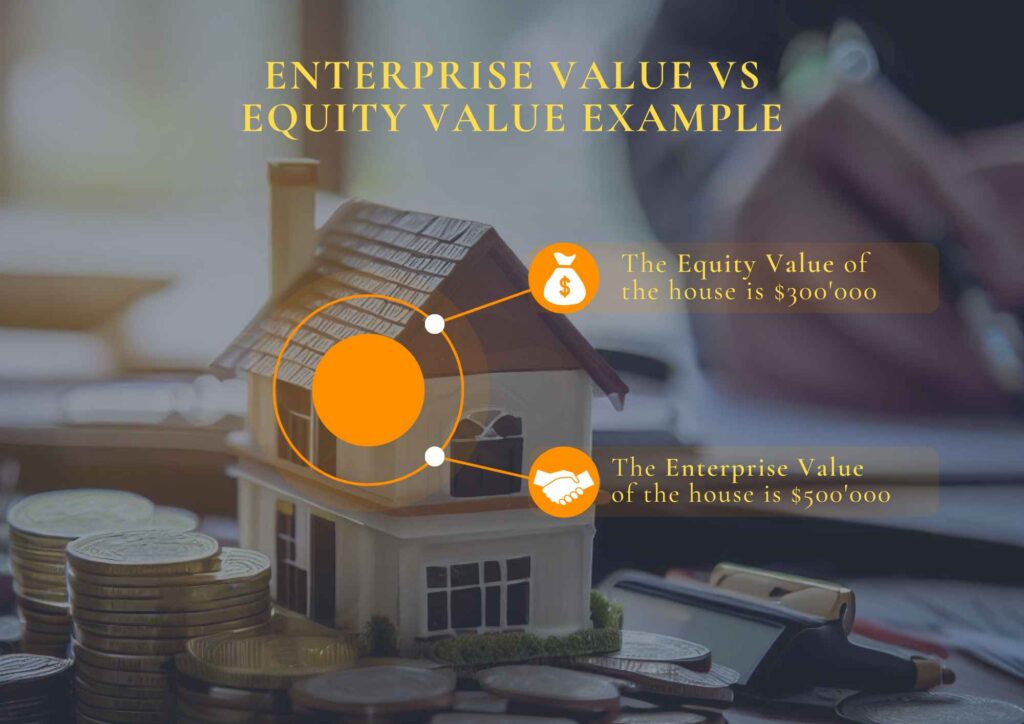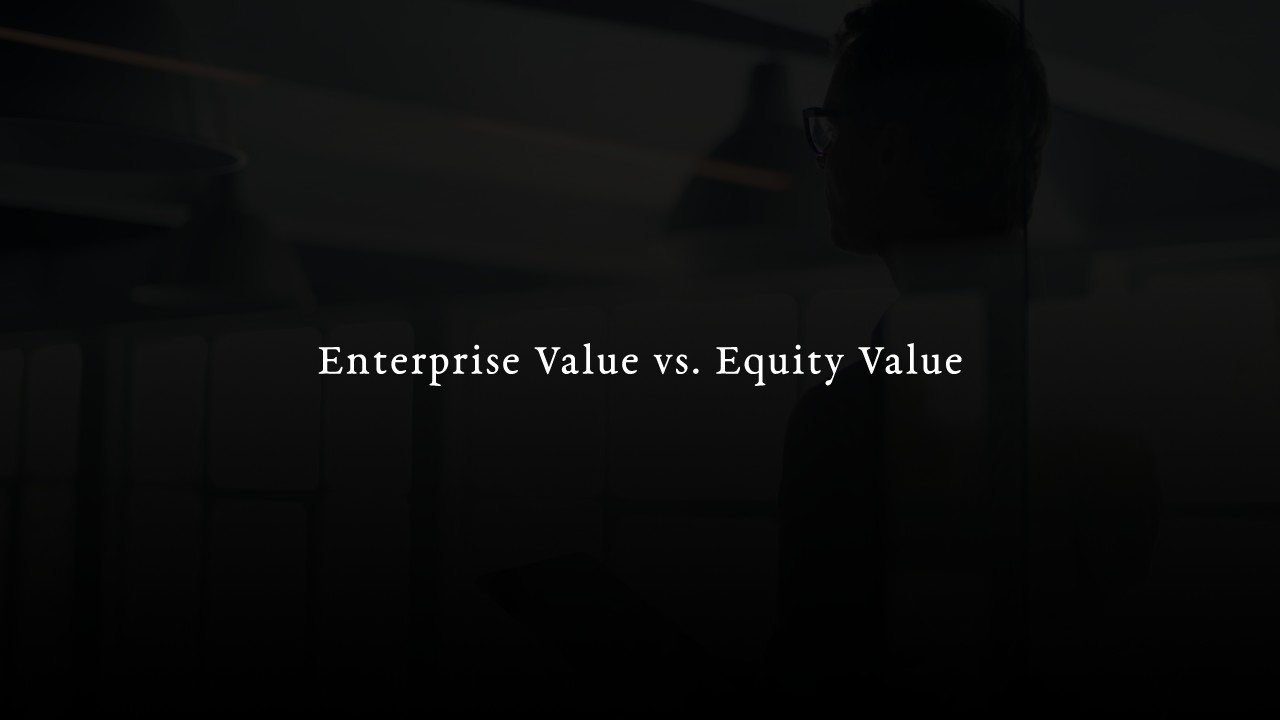Introduction
Enterprise value and equity value are two important concepts to understand when it comes to valuing a company. The purpose of this article is to investigate the perspectives behind the value formula, the bridge between these metrics, their role in M&A and criteria in multiples choice and comparison. Discounted Cash Flow (DCF) analysis is also an important tool in understanding the value of a company’s assets and liabilities: it allows investors to estimate the long-term value of a business based on its expected future cash flows and discount rate. By combining all of these metrics, investors can get an accurate picture of a company’s true worth, but all that glitters is not gold.
Table of Contents
- Introduction
- Difference between Equity and Enterprise Value
- DCF framework for valuation
- Calculation of Enterprise Value and Equity Value
- M&A deals: from value to purchase price
- Valuations using the right multiples
- Enterprise Value Vs. Equity Value Example
- Conclusions
- Bibliography
Difference between Equity and Enterprise Value
Equity value and enterprise value are both measures of a company’s value: equity value represents the value of a company’s equity (or ownership) on the stock market, while enterprise value represents the total value of a company’s business operations, including its debt and equity.
Equity value represents the value of a company’s equity, which is the amount of money that would be left over for shareholders if all of the company’s assets were sold and all of its debts were paid off. Equity value is calculated by subtracting a company’s liabilities (such as debt and other obligations) from its assets and dividing by the number of outstanding shares. Equity value is often used as a way to estimate a company’s market capitalization or its total value on the stock market.
Enterprise value, on the other hand, represents the total value of a company’s business operations, including both equity and debt. It is calculated by adding a company’s market capitalization (or equity value) to its total debt and subtracting its cash and cash equivalents. This measure takes into account a company’s ability to generate cash flow from its operations and its capital structure, and is often used in valuation analysis and in mergers and acquisitions.
DCF framework for valuation
Before we get to the nitty-gritty, some key considerations.
There are a number of ways for company valuation but here we want to focus on positive and negative cashflows, regardless of the accounting perspective. In this sense, the enterprise Discounted Cashflow (D.C.F.) and a WACC-driven approach are well fitting for us.
When should we use DCF based multiples in valuation? Discounted Cash Flow techniques works well with multi-business companies and stable Debt-to-Equity ratios. Indeed, using unlevered free cash flow with DCF means that we’re going to calculate the company value.
The framework allows us to see this value as Enterprise Value or Equity Value according to our point of view.
The basic formula is the same.
Calculation of Enterprise Value and Equity value
The Enterprise Value formula is
Share Price * Number of Shares + Debt – Cash
In other words, the sum of interest bearing-debt plus the market value of equity minus cash. Not by chance, the Enterprise Value can also be seen as the sum of operations and non-operating assets, where operations are merely the discounted value of future free cash flow (and this is why we use WACC).
A company’s enterprise value exceeds its invested capital if investors believe the company will create value. This is the main difference between Enterprise Value and Equity Value: Enterprise Value represents a more comprehensive measure of an organization’s value than Equity Value.
Thus, if we want to extract the value of the business attributable to just equity holders, we need to see value from the capitalization perspective. The market value, or market capitalization, is based on the stock price, which is inherently an equity value as equity investors value a company’s stock excluding debt lenders and other obligations (Pignataro, 2013).
The Equity Value formula is
Enterprise Value – Debt + Cash
Indeed, to convert enterprise value into equity value, subtract debt and other nonequity claims, such as unfunded retirement liabilities, capitalized operating leases, and outstanding employee options. Common equity is a residual claimant, receiving cash flows only after the company has fulfilled its other contractual claims (Koller et al., 2020). Dividing the estimated Equity Value to the most recent number of shares outstanding allows us to obtain an estimated value per share: the intrinsic value can be compared with market prices in order to find reasons behind the delta, opportunities and risks.
M&A deals: value, goodwill and purchase price
In Mergers and acquisitions (M&A), the transaction value may vary according to the negotiation terms. Enterprise Value is usually used when making an offer to acquire a business, and equity value is what the seller will actually receive. As a result of the deal, the actual purchase price may fall between Equity Value and Enterprise Value, or may be above it, or even below it.
As the unreported asset on the balance sheet, Goodwill plays a crucial role in company valuation and M&A deals. It’s scattered in the assets and so determining it is inevitably subjective. In fact, there are a number of techniques and officially methods used (IFRS treatment for instance).
In general terms, goodwill represents a premium paid for the growth assets of the target firm.
While in a deductive perspective, it can be seen as the part of NON-net identifiable assets acquired from the target firm (acquiree). So, Goodwill is calculated as the Enterprise Value of the target firm less than Net Value of its Assets and Liabilities.
Goodwill formula could alter comparable multiples. According to Damodaran, this is because the accounting aftermath of acquisitions – the creation of goodwill as an asset and its subsequent treatment – can affect both earnings and book value*, making multiples based on either number dicey (Damodaran, 2010).
The book value (BV) of a company is not the same as equity value: BV represents the value of a company's assets as listed on its balance sheet, after subtracting its liabilities. It is essentially the net worth of a company as calculated using accounting rules and historical cost, and it does not reflect any changes in the value of the company's assets over time.
Valuations using the right multiples
Primarily, we have to find out if we should use Enterprise Value or Equity Value. As it may be guessed, each offers a slightly different perspective when valuing or selling a business. Similar to a balance sheet, Enterprise Value offers an accurate assessment of the overall current value of a business, while Equity Value provides insight into both the current and potential future values of the business.
Obviously, the metric adopted varies according to the perspective: when looking at core business operations, all stakeholders prefer the Enterprise Value, while common shareholders prefer to focus on the equity, mostly if they are focusing on the current equity value, colloquially known as Market Cap (for public companies, Current Share Price * Shares Outstanding).
In addition, there are cases in which one or the other metric is not appropriate. For instance, using Enterprise Value for financial institutions or banks can be totally misleading: the core business of a bank, its debt structure and the role of interest is not suitable for the idea behind the Enterprise Value formula (equity-side metrics are better). Also, it is standard practice in private company valuation to reduce value by 20 to 25% to reflect illiquidity. Similar premiums/discounts are added/subtracted to reflect the effects of brand names and other intangibles and emerging-market risk. The net result of these adjustments is that the value reflects whatever preconceptions the analyst might have had about the company (Damodaran, 2010).
If the actual goal is to compare the performance of one company to another, we are aired by multiples. There is a universe of ratios, however, in order to gather an immediate appraisal we have to integrate both Enterprise and Equity Value with the right metric, and here is how:
In short, if the financial metric is before debt or interest, it is related to Enterprise Value (EV) – an enterprise value multiple.
If a financial metric you want to use as the comparable metric is after debt or interest, it must be related to Market Capitalization (P) – this is a market value multiple. (Pignataro, 2013).
Enterprise Value
This multiples type leads us to an indirect estimation of the value of equity by subtracting the market value of financial debt from the company value.
- EV/EBIT
- EV/EBITDA
- EV/Sales
Equity Value
This multiples type allow us to reach an estimate of the value of equity in a direct way.
- P/E
- P/CE (or Price/Cash earnings)
- P/BV
On average, it is better to invest in a company with a lower enterprise multiple when comparing similar companies. The thumb rule says that an EV/EBITDA is considered healthy if it is lower than 10. For instance, think about two companies with the same market cap:
| Market Cap | Debt | Cash | EV | EBITDA | EV/EBITDA | |
|---|---|---|---|---|---|---|
| A | $ 15 bn. | $ 10 bn. | $ 2 bn. | $ 23 bn. | $ 1.5 bn. | 15.3x |
| B | $ 15 bn. | $ 5 bn. | $ 7 bn. | $ 13 bn. | $ 1.5 bn. | 8.7x |
Enterprise Value Vs. Equity Value Example
Imagine a house that is worth $500,000 and isn’t currently able to generate cashflow. If the owner of the house has a mortgage of $200,000 on the property, then the equity value of the house would be $300,000 (the difference between the house value and the mortgage). However, the enterprise value of the house would be $500,000 (the total value of the house plus the outstanding mortgage).
So, the equity value represents the value of the house itself, and the enterprise value represents the value of the house plus any outstanding debts or mortgages.


Conclusions
On one hand, it is the objective of D.C.F. valuation to determine the value of an asset based on the cash flow, growth, and risk characteristics of the asset. On the other hand, relative valuation is based on current market prices for similar assets. Regardless of the way we calculate Enterprise Value, EBITDA, Equity or other multiples, it is crucial to understand the enterprise to equity bridge: moving from a metric unaffected by financing (EV) to a metric that actually is. Nonetheless, the estimation of growth prospects and risk profiles have to be as objective as possible, the personal adjustments has to be minimized and variables of the chosen comparable companies has to be founded on objective criteria.
Bibliography
DAMODARAN A. (2010). The dark side of valuation: valuing young, distressed and complex businesses. Upper Saddle River, New Jersey: Pearson Education, Inc.
KOLLER T., GOEDHART M., WESSELS D. (2020). Valuation: Measuring and Managing the Value of Companies. John Wiley & Sons, Inc.: Hoboken, New Jersey.
MASSARI M., GIANFRATE G., ZANETTI L. (2016). Corporate Valuation: Measuring the Value of Companies in Turbulent Times. John Wiley & Sons, Inc.: Hoboken, New Jersey.
PIGNATARO P. (2013). Financial Modeling and Valuation. Hoboken, NJ: John Wiley & Sons.

